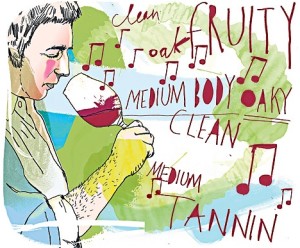Few simple tricks on How to Taste Wine
If you have ever visited the wine growing regions of the world, you will have undoubtedly sampled the rewards of a wine tasting. If you want to enjoy the beauty of wine then a few simple steps is all you need to follow.
Most, if not all, of your senses will come into play when tasting the wine and it is an experience not to be missed.
 When you tilt the glass you will get some idea as to the wine’s age and how heavy it is. When you evaluate a wine by the method of taste you must remember that our taste buds will pick up bitter, sweet, sour and salt as the main components of any drink or food item.
When you tilt the glass you will get some idea as to the wine’s age and how heavy it is. When you evaluate a wine by the method of taste you must remember that our taste buds will pick up bitter, sweet, sour and salt as the main components of any drink or food item.
When you taste your wine, which taste do you immediately associate with the wine when you taste it?
Here are few tips to help you with your wine tasting:
- Take a long hard look at the wine you are about to taste. Tilt the glass from one side to the other and see if there are any contrasting colour spectrums. Be sure to hold the glass in front of a white background and not against a background with many garish colours. You are checking here for clarity, depth and how deep the wine’s colour has been saturated. Remember that white wine becomes darker as it ages, and reds could go towards more of a brown hue.
- Allow the wine to become oxygenated by swirling it around in the glass. This will allow the aroma to be released and gets you ready for the next stage, where you will use your sense of smell.
- You should at first hold the glass around four or five inches away from your nose before moving your nose over the top of the glass. Think carefully about what you smell here; is it sharp or heavy and does the aroma hit the back of your throat?
- Take a sip of the wine but do not swallow just yet; swirl around in the mouth first, then roll it into every corner of your mouth allowing all the taste buds to experience the flavour. The main taste varieties will be salt, savoury, sour, bitter and sweet. Also take note of the wine’s texture during this swirling process. Is it smooth or washy and does it have body or weight.
- Draw a small bit of air into your mouth by breathing out of your nose to liberate the aroma of the wine. What you are doing here is to sense whether the wine has interacted with your saliva and taste buds in your gums.
- Take a final sip of the wine by slurping it. This allows air to interact with the wine. You will notice at first that there are differences in the texture and flavour than when you sipped the wine.
What you should finish off with is that feeling of after-taste, it is more of a sensation you should note down rather than perform. Try pairing your wine with different foods to experience differing enhancements in the taste of the wine.
Alex





